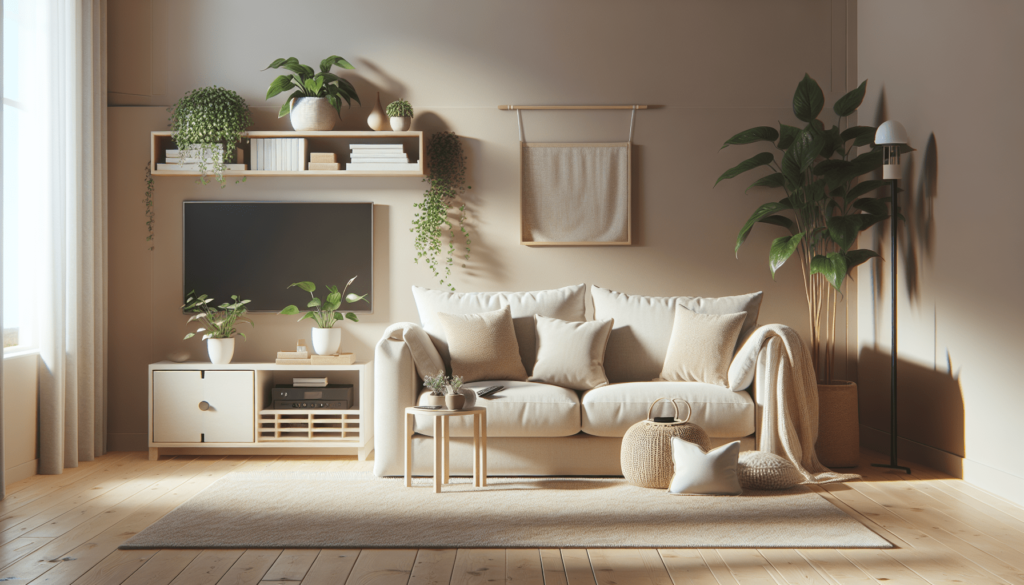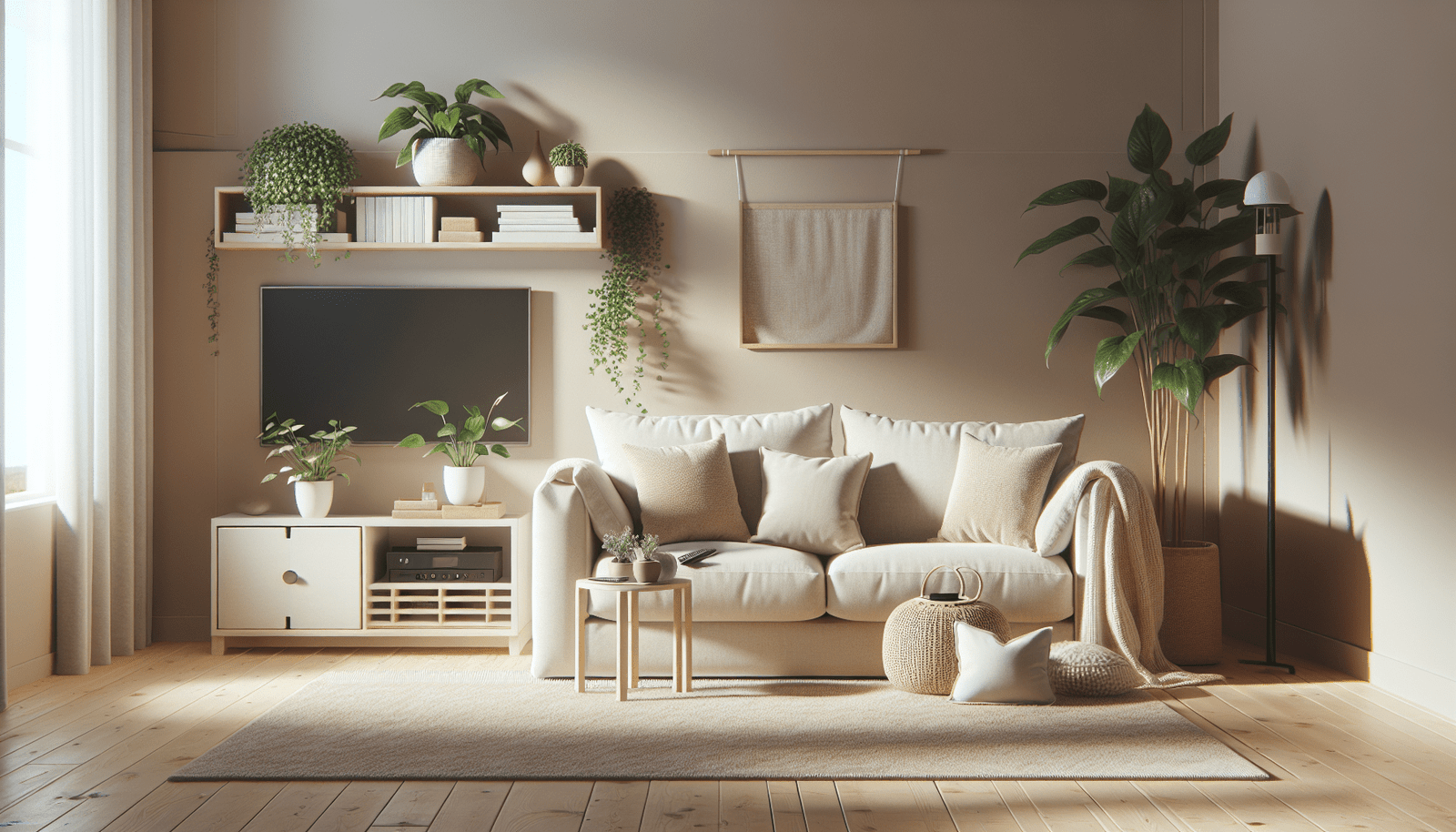Have you ever wondered how to make your living room both stylish and allergy-friendly? Crafting a comfortable and inviting space that minimizes allergens is not only possible but also life-enhancing for you and your loved ones. Whether it’s for watching your favorite shows or hosting family movie nights, transforming your entertainment area into a sanctuary is simpler than you might think. This guide will walk you through designing an allergy-free living room entertainment area, turning your home into a comfortable and healthy haven.

Understanding Allergens in Your Living Room
To create a truly allergy-friendly space, it’s first important to understand what allergens might be lurking in your living room. Common culprits include dust mites, pet dander, pollen, mold, and VOCs (Volatile Organic Compounds) found in some household cleaners and furniture products. Identifying these triggers is the first step in reducing or eliminating them from your entertainment area.
Dust Mites
Dust mites are microscopic organisms that thrive in warm, humid environments and are commonly found in household dust. These tiny creatures can trigger allergies and worsen asthma symptoms. Reducing their presence involves regular cleaning and choosing the right materials for your furniture and décor.
Pet Dander
Pet owners often struggle with pet dander, which is comprised of tiny, even microscopic, flecks of skin shed by cats, dogs, rodents, birds, and other animals with fur or feathers. Dander can adhere to furniture, walls, and fabrics around your living room, making it crucial to select materials that can repel or easily release these particles with cleaning.
Pollen
Pollen can waft into your home through open windows, doors, and on clothing. While it’s not possible to avoid pollen entirely, you can take steps to limit its presence in your living area. Understanding the best practices can help keep this outdoor allergen at bay.
Mold
Mold thrives in damp environments and can develop in places like window sills, plants, or even in walls if there’s hidden moisture. It’s essential to control humidity levels and address any moisture issues promptly to reduce mold risk.
Volatile Organic Compounds (VOCs)
VOCs are chemicals released by a wide array of products, including those used in household cleaning, fragrances, and even in some building materials or furniture. These compounds can be a significant concern for those with respiratory issues or sensitivities, making the selection of low-VOC products a priority for an allergen-free home.
Choosing the Right Furniture for an Allergy-Friendly Space
When designing an allergy-friendly room, your choice of furniture is paramount. Consider materials and fabrics that repel allergens and are easier to clean, helping you maintain a tidy and allergen-free environment.
Hypoallergenic Fabrics
Opt for furniture with hypoallergenic fabric coverings. Materials like leather or faux leather are excellent options because they don’t trap allergens as much as woven fabrics do. Additionally, they’re easy to wipe down and maintain.
Replaceable and Washable Covers
Furniture with washable covers can make a significant difference in managing allergens. Being able to remove and wash covers regularly ensures that dust mites and pet dander don’t accumulate.
Solid Wood Furniture
Where possible, select furniture made of solid wood rather than particleboard, which often contains formaldehyde, a VOC. Solid wood is a naturally hypoallergenic option that doesn’t release harmful chemicals over time.
Floors and Carpets: Making Allergy-Friendly Choices
The floor, often overlooked, can be a major player in your battle against allergens. The right flooring choices will vastly improve the air quality in your living room.
Hard Flooring vs. Carpeting
Hard flooring options like hardwood, tile, or laminate are better for those with allergies because they don’t trap dust or pollen as carpets do. If you love the warmth of carpet, consider low-pile carpets that trap fewer allergens and can be vacuumed easily.
Area Rugs
If you’d like to add some warmth or texture to your hard flooring, select washable area rugs. Just like with furniture, regularly washing these rugs can help significantly reduce allergens.
Regular Cleaning Routine
Regardless of the flooring choice, establish a regular cleaning schedule. Using a vacuum with a HEPA filter can help capture and contain allergens, making your cleaning efforts much more effective.
Managing Air Quality for an Allergen-Free Living Space
Ensuring the air quality in your living room is crucial for allergen control. Air purifiers and proper ventilation can dramatically improve the environment.
Air Purifiers
An air purifier with a HEPA filter can capture airborne particles, significantly improving indoor air quality. Place it strategically in the living room where you spend most of your time for maximum effect.
Houseplants
Interestingly, some houseplants can help clean the air by absorbing VOCs. Plants like snake plants and spider plants are not only attractive but also beneficial in improving air quality. However, be cautious, as some plants can also contribute to humidity and mold growth if overwatered.
Ventilation
Ensuring proper ventilation with exhaust fans or by simply opening windows when pollen levels are low can also assist in maintaining clean air. Fresh air circulation prevents stuffiness and reduces pollutant concentration indoors.

Decor Elements: Allergy-Friendly Alternatives
Decorating a space to be both beautiful and allergy-friendly involves thoughtful choices. From paint to embellishments, every piece can contribute to the overall allergen load.
Low-VOC Paints
When painting your living room, choose low-VOC or zero-VOC paints to reduce exposure to harmful chemicals emitted during the drying process and beyond. These are widely available and come in all paint finishes.
Minimalist Design
A minimalist approach will naturally reduce places for dust to accumulate. Choosing fewer, high-impact pieces will make regular cleaning easier and more effective.
Cleaning and Maintenance
Regular upkeep can make a world of difference in maintaining your living room as an allergy-friendly zone. Each piece of furniture and element of the room plays a part in the whole ecosystem of the space.
Smart Technology to Enhance Your Living Space
In today’s tech-savvy world, leveraging technology can aid in creating a healthier environment. From smart thermostats to air quality monitors, technology offers modern solutions for reducing allergens.
Smart Thermostats
Controlling the temperature with smart thermostats can help manage dust mite proliferation. Keeping your home cool and less humid deters dust mites from thriving.
Air Quality Monitors
Air quality monitors give you real-time information about particles in your air. Knowing what you’re dealing with can help you pursue targeted measures to improve air quality more effectively.
A Personal Touch: Tailoring Your Space
While an allergy-friendly design should adhere to principles of health and comfort, it’s important that your living room also reflects your personal style. Select colors, patterns, and elements that resonate personally to feel truly at home.
Personalizing without Compromise
Integrating personal elements does not need to clash with health considerations. Linen or organic cotton throw blankets and certified organic cushions are just a few examples of integrating personal style while staying allergy conscious.
Regular Habits for Long-Term Indoor Air Quality
Once your living room is set up to be allergy-friendly, maintaining this space requires regular attention. Consistent habits will ensure your allergen levels remain low over time.
Cleaning Schedule
Establish a weekly cleaning routine that covers dusting, vacuuming, and washing surfaces. This simple habit can drastically reduce the allergen load in your home.
Humidity Control
Managing humidity levels with a dehumidifier or humidifier can also aid in preventing mold growth and keeping dust mites at bay. Aim for a comfortable 40-50% humidity level.
Maintaining an allergy-friendly living room is a practice in both design and routine. By making informed choices from furniture to air quality solutions, you can create a space that is not only aesthetically pleasing but also promotes health and wellness for you and your family. Each element, from flooring to fabrics, plays a crucial role in this delicate balance, making the living room a comfortable, inviting, and healthy space to enjoy all your favorite activities uninterrupted.
